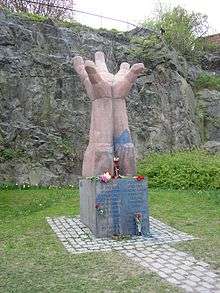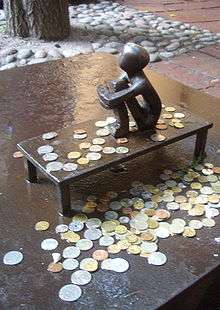Liss Eriksson

La Mano.
Aunt, granite, Västertorp Sculpture Park, Stockholm. Photo: Bengt Oberger

"Boy looking at the moon" at Bollhustäppan in Gamla stan.
Liss Eriksson (31 August 1919–19 July 2000) was a Swedish sculptor.
Life
The son of the sculptor Christian Eriksson (1858-1935), Liss Eriksson grew up on Maria Prästgårdsgatan on Södermalm in southern-central Stockholm. Following his studies at the College of Fine Arts for Nils Sjögren and Eric Grate in 1939-1944, Liss participated in the pioneering exhibition Ung Konst in 1947, before spending five years in Paris together with his wife, the artist Britta Reich-Eriksson, to study for Jean Osouf and Henri Laurens. He returned to Stockholm in 1951, in 1975 succeeding the studio of his father previously used by Sven 'X:et' Erixson (1899-1970). During his last years, he was working on a retable for the church Katarina kyrka, near his home.[1][2]
List of works
- Pojke som tittar på månen ("Boy Looking at the Moon"), Stockholm, 1967
- La Mano, (Spanish: The Hand), Stockholm, 1977
- Paret, 1976, Stockholm [3]
- Huset ("The House"), Lund
- Korsgestalten och Den uppståndne ("The Crucified and the Risen"), Strömstad
- Ögat ("The Eye"), Norrtälje
- La Pucelle (French: The Virginity), 1950, Lidingö
- Stående kvinna ("Standing Woman")[4]
- Mor och barn ("Mother and child")[5]
- Ciss III - porträtthuvud ("Ciss III - Portrait")[6]
- Faster ("Aunt"), Västertorp[7]
- FN-monumentet ("The UN Monument"), Djurgården
- Den dövstumme negern ("The Deaf-mute Negro")[8]
- Källan ("The Source"), Stockholm[9]
References
- ↑ "Skulpturvandring Liss Eriksson". City of Arvika. Retrieved 2007-02-16.
- ↑ "Liss Eriksson". Cultural Society of Gnesta (Gnesta Kulturförening). September 2003. Retrieved 2007-02-16.
- ↑ Art in Uppsala
- ↑ artnet
- ↑ artnet
- ↑ artnet
- ↑ City of Stockholm
- ↑ "Den dövstumme negern". Bukowski. Archived from the original on September 27, 2007. Retrieved 2007-02-16.
- ↑ A P Sten
This article is issued from Wikipedia - version of the 9/9/2016. The text is available under the Creative Commons Attribution/Share Alike but additional terms may apply for the media files.